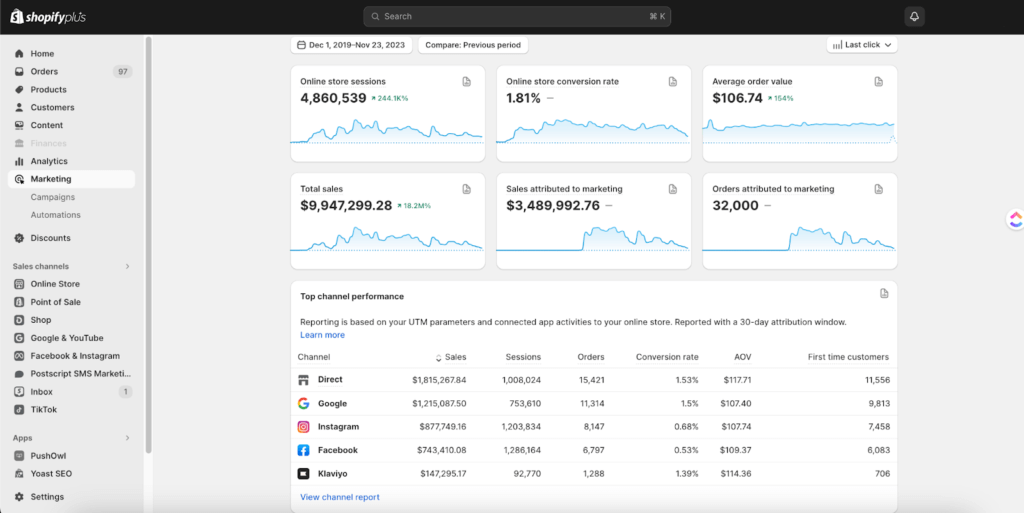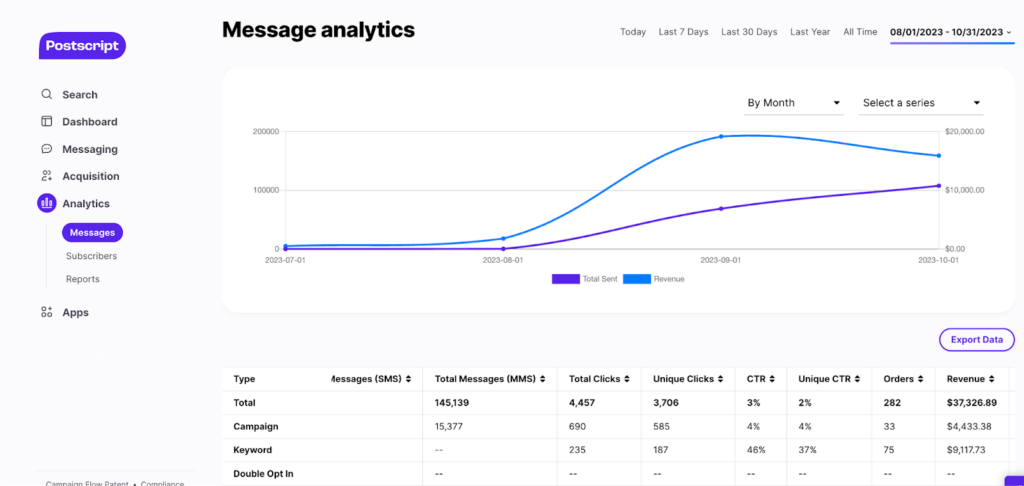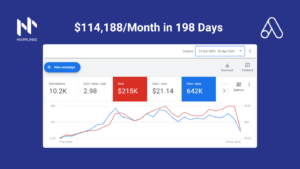As an ecommerce marketing agency, Mapplinks specializes in crafting data-driven strategies and executing full-funnel e-commerce marketing campaigns.
We worked with a boutique fashion brand that used to sell only on wholesale channels to build up its brand from scratch and scale it to $10M+ in revenue.
This is a detailed case study of how we achieved these results within 3 years. 0 to $1M+ in the first year, $4M in the second, and we hit $10M by the end of 3 years.

We’ll break down all the steps we followed and the marketing channels we used.
The Goal
The client, a boutique fashion brand, approached us intending to increase their online sales significantly.
Our key objectives were:
- Increase Overall Revenue: Scale the brand to 7 figures in annual sales
- Expand Customer Base: Acquire new customers while retaining the existing ones
- Optimize Marketing Spend: Ensure efficient use of marketing budget to maximize ROI
This is what we call an ‘acquisition-focused’ brand.
In a highly competitive fast-fashion space, we created an omnichannel full-funnel marketing strategy with multiple customer touchpoints for the client.
The Strategy
An effective omnichannel marketing strategy integrates various channels to provide a seamless customer experience. This involves performance marketing, retention marketing, and website optimization through conversion rate optimization (CRO).
Below, we break down each component and explain how they work together to create a cohesive omni-channel strategy.
Performance Marketing
This was our main source of acquiring new users.
We focused on the following key channels:
- Meta Ads (Facebook & Instagram Ads)
- Google Ads
- Pinterest Ads
- Bing Ads
- TikTok Ads
This mix allowed us to reduce dependency on a single channel and have a diversified mix of channels.
On Meta, we followed a creative-led approach with constant creative testing and product testing since the client had a huge catalog of products.
On Google, we focused on Google shopping campaigns and pmax campaigns.

Performance marketing metrics:
- We maintained a cost per conversion within a reasonable range (around $28-$34) and a return on ad spend (ROAS) between 3x and 5x.
- The ROAS target changed as we focused on scaling periods vs stable periods but remained within this range even at a 6-figure monthly ad spend.
- We maintained a stable average cost per click (CPC) around $0.8-$0.9.

Conversion Rate Optimization
Our Conversion Rate Optimization (CRO) process is designed to systematically analyze, test, and enhance the performance of our clients’ websites, ensuring they convert visitors into customers more effectively.

Shopify Analytics over the year
There are 2 key metrics on your store:
- Conversion Rate: This is usually between 1-4% for boutique fashion brands. The conversion rates are higher for brands driving organic traffic, and on the lower side for brands driving mostly new traffic from ads.
- Average Order Value: This is based on the product pricing and the total cart value. Higher the AOV, usually lower the conversion rates.
We focused on CRO for the initial time period to improve our ROAS. While often overlooked, boosting conversion rates is a great way to improve ROAS.
Here’s a detailed explanation of our CRO process:
1. Initial Analysis and Benchmarking
Objective: Understand the current performance and identify areas for improvement.
Steps:
- Analytics Review: Use tools like Google Analytics, Hotjar, and Crazy Egg to gather data on user behavior, traffic sources, conversion rates, and more.
- Heatmaps and Session Recordings: Analyze heatmaps and session recordings to see how users interact with the site.
- Benchmarking: Establish baseline metrics for current conversion rates and key performance indicators (KPIs).
2. Understanding the Audience
Objective: Gain deep insights into who the users are, their needs, pain points, and behaviors.
Steps:
- Customer Surveys and Feedback: Conduct surveys and collect feedback to understand user expectations and barriers.
- User Personas: Create detailed user personas based on demographic, psychographic, and behavioral data.
- User Journey Mapping: Map out the user journey to identify drop-off points and friction areas.
3. Identifying Conversion Roadblocks
Objective: Pinpoint specific issues that prevent users from converting.
Steps:
- Usability Testing: Conduct usability tests to identify issues in the user experience (UX).
- A/B Testing: Run A/B tests on different elements (headlines, CTAs, forms, etc.) to determine what works best.
- Technical Audit: Check for technical issues such as slow load times, broken links, and mobile responsiveness.
4. Hypothesis Development
Objective: Formulate hypotheses on how to improve conversions based on the data and insights collected.
Steps:
- Problem Statements: Clearly define the problems affecting conversion rates.
- Hypotheses Creation: Develop hypotheses on how to solve these problems. For example, “If we simplify the checkout process, then the conversion rate will increase.”
5. Prioritizing Tests
Objective: Determine which tests to run first based on potential impact and feasibility.
Steps:
- Impact vs. Effort Matrix: Use an impact vs. effort matrix to prioritize tests that are likely to have the highest impact with the least effort.
- Test Plan: Develop a detailed test plan outlining the tests to be conducted, the elements to be tested, and the metrics to be measured.
6. Running Experiments
Objective: Execute the planned tests and gather data.
Steps:
- A/B Testing Tools: Use tools like Optimizely, VWO, or Google Optimize to run A/B tests.
- Split Testing: Conduct split testing to compare different versions of a webpage or element.
- Multivariate Testing: For more complex scenarios, use multivariate testing to understand how different combinations of elements perform together.
7. Analyzing Results
Objective: Evaluate the results of the tests to determine the effectiveness of the changes.
Steps:
- Data Analysis: Use statistical analysis to interpret the test results.
- Winning Variations: Identify winning variations based on performance metrics.
- Insights Documentation: Document the insights gained from the tests and how they align with the initial hypotheses.
8. Implementation and Iteration
Objective: Implement successful changes and continue to iterate for continuous improvement.
Steps:
- Deploy Changes: Roll out the winning variations to all users.
- Monitor Performance: Continuously monitor performance to ensure sustained improvement.
- Iterative Testing: Continue testing new hypotheses and optimizing different elements for ongoing CRO.
9. Reporting and Communication
Objective: Keep stakeholders informed about the progress and results of CRO efforts.
Steps:
- Regular Reports: Provide regular reports detailing the tests conducted, results, and next steps.
- Dashboard Creation: Create dashboards for real-time monitoring of key metrics.
- Stakeholder Meetings: Hold regular meetings with stakeholders to review progress and discuss future strategies.
Retention Marketing
Overview: Retention marketing focuses on retaining existing customers and increasing their lifetime value. This involves personalized communication, loyalty programs, and nurturing relationships through email marketing and other channels.
Key Components:
- Email Marketing: Using email campaigns and automation to engage customers with personalized messages.
- Loyalty Programs: Rewarding repeat customers with points, discounts, or exclusive offers.
- Customer Feedback: Collecting and acting on customer feedback to improve products and services.
- Customer Support: Providing excellent support to resolve issues and maintain customer satisfaction.
Strategy:
- Segmentation: Segment your customer base to deliver targeted messages based on their behavior and preferences.
- Automations: Set up automated workflows for welcome series, abandoned cart reminders, post-purchase follow-ups, and re-engagement campaigns.
- Content Personalization: Use customer data to personalize email content, offers, and product recommendations.
Engagement platforms like Emotive, Postscript and Klaviyo became our tools to build connections with the audience.

We created targeted campaigns that resonated deeply by segmenting and tailoring messages based on their interests and purchase history.
This eliminated the feeling of spam and transformed our email and SMS marketing into a valuable resource, providing helpful content and exclusive offers that enhanced the customer journey and ultimately led to a more exceptional shopping experience.
Emotive
We partnered with Emotive and later switched to PostScript to build a robust SMS subscriber list by encouraging phone number sign-ups. This allowed us to send personalized, conversational SMS messages that resonated with customers and drove sales.
Results Obtained
- Growth: Revenue nearly doubled year-over-year, reaching the all-time highest $1M, showcasing strong brand appeal.
- Acquisition: We attracted new subscribers at a fantastic rate, exceeding 30,000 over the year ( 2021 – 2023). This suggests our strategy was effective and resonated with the target audience.
- Spending: Revenue consistently outpaces marketing spend, indicating a return on investment and a sustainable growth model.
Emotive case study report over the year
Postscript
We leveraged Postscript’s functionalities to craft highly targeted email campaigns that transcended a robotic feel.

These campaigns went beyond simply sending information; they nurtured leads by providing valuable content. This human touch ultimately paid off, converting many recipients into paying customers.
Klaviyo
We utilized Klaviyo advanced email marketing features to craft data-driven campaigns that resonated with specific customer segments. By analyzing campaign performance, we continuously optimized messaging and targeting, ensuring maximum engagement.

Klaviyo case study results
Results
- Revenue Growth: Klaviyo campaigns directly generated $244,000 in revenue. This indicates that our Klaviyo efforts have been successful in driving sales and contributing to the overall business growth.
- Return on Ad Spend (ROAS): Your Klaviyo campaigns’ ROAS is almost always positive, meaning the revenue generated outweighs the cost of running them.
- Efficient Use of Klaviyo:The fact that the total revenue ($698,000) for the past year surpassed the campaign spend ($286,000) further highlights Klaviyo’s efficiency. This suggests we’re getting a good return on your investment in Klaviyo, and it’s effectively contributing to the brand’s sales strategy.

PushOwl
PushOwl is a web push notification app designed specifically for Shopify stores. It allows you to send marketing messages directly to your website visitors’ screens, even if they haven’t signed up for an email list.

PushOwl Campaign Revenue

PushOwl Automation Revenue
- Campaigns: Our manually created notifications sent out for specific promotions or announcements generate significant impressions (222K).
- Automations are pre-set notifications triggered by specific customer behaviors, like abandoned carts or product reviews. Despite having a much lower number of impressions (11K), they boast a higher CTR, translating into 423 clicks and a surprising $21K in revenue.
Conclusion
Boutique Fashion Level’s remarkable success highlights the effectiveness of a well-rounded and meticulously executed marketing strategy. By integrating performance marketing, conversion rate optimization, and retention marketing, we were able to drive significant growth and achieve impressive results for the brand.
Our approach focused on leveraging in-depth customer insights and utilizing advanced marketing tools to deliver targeted and personalized experiences. This strategy increased revenue and built a loyal customer base that continues to drive sustainable growth.
We created a scalable and successful marketing framework by prioritizing data-driven decisions, continuous optimization, and a comprehensive understanding of the customer journey.
If you are looking to elevate your brand and achieve similar success, consider partnering with Mapplinks. Our expertise in full-funnel growth marketing can help you unlock your brand’s potential and drive significant results.
Book your free consultation now with our team of e-commerce experts here.



